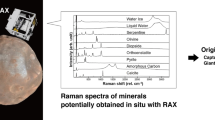Abstract
For the first time in history, a Mössbauer spectrometer was placed on the surface of another planet. Our miniaturized Mössbauer spectrometer MIMOS II [1–4] (Figure 2) is part of the instrument payload of NASA’s twin Mars Exploration Rovers (MER) “Spirit” and “Opportunity” (see Figure 1), which in January 2004 successfully landed at the Gusev crater and the Meridiani Planum landing sites, respectively. MIMOS II determines the Fe-bearing mineralogy of Martian soils and rocks at the Rovers’ respective landing sites [5]. The main goals of this planetary twin mission are to: (1) identify hydrologic, hydrothermal, and other processes that have operated and affected materials at the landing sites; (2) identify and investigate the rocks and soils at both landing sites, as there is a possible chance that they may preserve evidence of ancient environmental conditions and possible prebiotic or biotic activities. With MIMOS II, besides other minerals the Fe silicate olivine has been identified in both soil and rocks at both landing sites. At the Meridiani site the Fe sulfate jarosite has been identified by MIMOS II which is definitive mineralogical proof of the presence of water at this site in the past.
Similar content being viewed by others
References
Klingelhöfer G., Morris R. V., Bernhardt B., Rodionov D., de Souza P. A. Jr., Squyres S. W., Foh J., Kankeleit E., Bonnes U., Gellert R., Schröder Ch., Linkin S., Evlanov E., Zubkov B. and Prilutski O., J. Geophys. Res. 108(E12) (2003), 8067.
Klingelhöfer G., In: Miglierini M. and Petridis D. (eds.), Mössbauer Spectroscopy in Materials Science, Kluwer Academic Publishers, Dordrecht, 1999.
Klingelhöfer G., Hyperfine Interact. 113 (1998), 369–374.
Squyres S. W. et al., J. Geophys. Res. 108(E12) (2003), 8062.
Several papers in special volume of: Science, vol. 305 (6 August 2004).
Klingelhöfer G., Morris R. V., Bernhardt B., Schröder C., Rodionov D. S., de Souza P. A. Jr., Yen A., Gellert R., Evlanov E. N., Zubkov B., Foh J., Bonnes U., Kankleit E., Gütlich P., Ming D. W., Renz F., Wdowiak T., Squyres S. W. and Arvidson R. E., Science 306 (3 December 2004), 1740–1745.
Morris R. V., Klingelhöfer G., Bernhardt B., Schröder C., Rodionov D. S., de Souza P. A. Jr., Yen A., Gellert R., Evlanov E. N., Foh J., Kankleit E., Gütlich P., Ming D. W., Renz F., Wdowiak T., Squyres S. W. and Arvidson R. E., Science 305 (6 August 2004), 833–836.
Author information
Authors and Affiliations
Corresponding author
Rights and permissions
About this article
Cite this article
Klingelhöfer, G. Mössbauer In Situ Studies of the Surface of Mars. Hyperfine Interact 158, 117–124 (2004). https://doi.org/10.1007/s10751-005-9019-1
Published:
Issue Date:
DOI: https://doi.org/10.1007/s10751-005-9019-1




